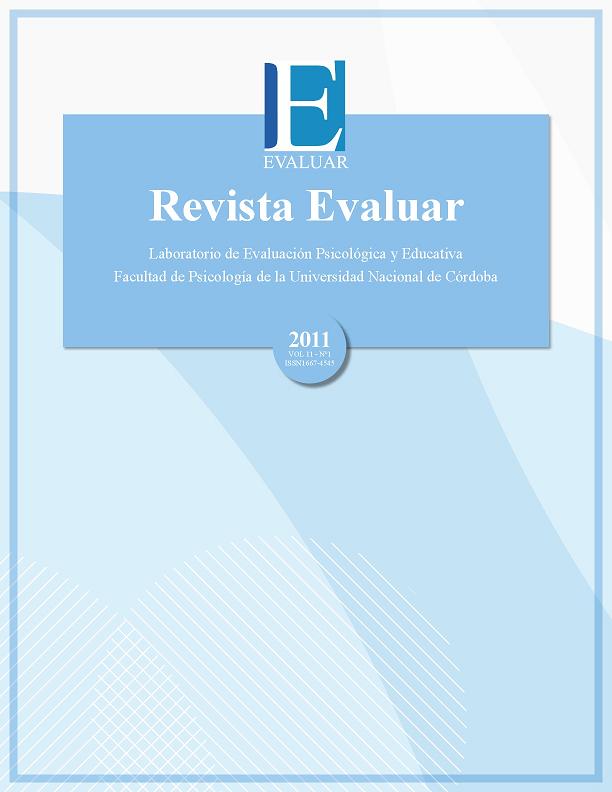Trends in statistical analysis: The frequentist inference limitations and the possibilities of the Bayesian approach.
DOI:
https://doi.org/10.35670/1667-4545.v11.n1.2842Keywords:
inferencia frecuencial, inferencia bayesiana, prueba de hipotesis, estadistica en psicologiaAbstract
Statistical procedures used in psychological research are in full review. The accumulation of criticism upon classical techniques has led to different answers. On one hand, there is a deepening on pushing analysis beyond hypothesis testing and more elaborate interpretation of data. On the other hand, more and more researchers suggest introducing Bayesian approach to make inferences, and there are more software routines to facilitate this. On the frequentist approach, this paper discusses additional procedures to test hypotheses suggested in the sixth edition APA Publication Manual. We review the rationale of hypothesis testing; we show the usefulness of reporting effect size measures ―and the difficulty to infer about them―, power analysis, and the different alternatives to calculate confidence intervals. On the Bayesian approach, we discuss the assumptions and the advantages in terms of information it offers and its contribution to the cumulative nature of the results. Then we show a simple illustrative application of its rationale, comparing the estimation of proportions by means of credibility and confidence intervals.
Downloads
References
Agresti, A. & Coull, B. (1998). Approximate is Better than “Exact” for Interval Estimation of Binomial Proportions. The American Statistician, 52(2), 119–126.
APA (2010). Publication Manual of the American Psychological Association Sexta Edición. APA: Washington, DC.
Bayes, T. (1763). An Essay towards solving a Problem in the Doctrine of Chances. Philosophical Transactions of the Royal Society of London 53: pp. 370–418.
Bellhouse, D. (2004). The Reverend Thomas Bayes, FRS: A Biography to Celebrate the Tercentenary of HisBirth, Statistical Science, 19(1), 3–43. Disponible en http://www.york.ac.uk/depts/maths/histstat/bayesbiog.pdf
Berkson, J. (1938). Some difficulties of interpretation encountered in the application of the chi-square test. Journal of the American Statistical Association, 33, 526-542.
Buckingham, J., Smith LeBeau, L. & Klein, W. (2011). The performance versus ability distinction following social comparison feedback. Current Research in Social Psychology. Disponible en http://www.uiowa.edu/~grpproc/crisp/crisp16_7.pdfaccedida el 20/4/2011
Caballero Granado, F. (2007). Inferencia estadística según el modelo bayesiano Sociedad Andaluza de Enfermedades Infecciosas. Disponible en http://saei.org/hemero/epidemiol/nota3.html accedida el 5/3/2011
Cepeda-Cuervo, E., Aguilar, W., Cervantes, V., Corrales, M., Díaz, I. & Rodríguez, D. (2008). Intervalos de confianza e intervalos de credibilidad para una proporción. Revista Colombiana de Estadística, 31(2), 211-228. Disponible en http://www.kurims.kyoto-u.ac.jp/EMIS/journals/RCE/V31/bodyv31n2/v31n2a06CepedaEtAl.pdf
Coello, M. y Fernández, J. (2011). Actitudes hacia las mujeres de los esquemáticos frente a los no esquemáticos de género. Psicothema, 23(2), 180-188. Universidad Complutense de Madrid, Disponible en http://www.psicothema.es/pdf/3868.pdf accedida el 20/4/2011
Cohen, J. (1994). The earth is round (p < .05), American Psychologist 49(12), 997–1003. Cumming, G. (2011). Exploratory Software for Confidence Intervals, ESCI http://www.latrobe.edu.au/psy/esci/ accedida el 26/6/2011
Denis, D. (2003). Alternatives to null hypothesis significance testing. Theory & Science, 4.
Díaz Batanero, C. (2007). Introducción a la Inferencia Bayesiana. Granada: La autora.
Díaz Batanero, C. (2007). Viabilidad de la Enseñanza de la Inferencia Bayesiana en el Análisis de Datos en Psicología. Tesis doctoral. Universidad de Granada. Departamento de Psicología Social y Metodología de la Ciencias del Comportamiento. Disponible en http://hera.ugr.es/tesisugr/16582664.pdf accedida 10/12/2010
Díaz, C., Batanero, C., & Wilhelmi, M. (2008). Errores Frecuentes en el Análisis de Datos en Educación y Psicología. Publicaciones.
Eberly, L. & Casella, G. (2003). Estimating Bayesian credible intervals. Journal of Statistical Planning and Inference, 112, 115–132. Disponible en www.elsevier.com/locate/jspi accedida el 24/05/2012
Ellis, P. (2010). The Essential Guide to Effect Sizes Statistical Power, Meta-Analysis and the Interpretation of Research Results. Cambridge University Press:UK.
Fisher, R. A. (1959). Statistical methods and scientific inference. New York: Hafner Publishing.
Haller, H. & Krauss, S. (2002). Misinterpretations of Significance: A Problem Students Share with Their Teachers? Methods of Psychological Research Online, 7(1), Institute for Science Education. Disponible en http://www.dgps.de/fachgruppen/methoden/mpr-online/issue16/art1/haller.pdf accedida 5/10/2010
Howell, D. (2010). Confidence Intervals on Effect Size. Disponible en http://www.uvm.edu/~dhowell/methods8/Supplements/Confidence%20Intervals%20on%20Effect%20Size.pdf accedida 3/7/2011
Kirk, R. (1996). Practical significance: A concept whose time has come. Educational and Psychological Measurement, 56(5), 746-759.
Krueger, J. (2001). Null hypothesis significance testing: On the survival of a flawed method. American Psychologist, 56(1) 16-26.
Larsson, R. (2011). How Informative is a Noninformative Prior? Documento de Trabajo 2. Departamento de Estadística. Universidad de Upsala. Disponible en www.statistics.uu.se accedida el 30/5/2012
Lipsey, M. W. (1990). Design Sensitivity: Statistical Power for Experimental Research. Newbury Park, CA: Sage.
Meehl, P. (1967). Theory-testing in Psychology and Physics: A methodological paradox Philosophy of Science, 34, 103–115.
Meehl, P. (1978). Theoretical Risks and Tabular Asterisks: Sir Karl, Sir Ronald, and the Slow Progress of Soft Psychology. Journal of Consulting and Clinical Psychology, 46, 806-834.
Meehl, P. (1997). The problem is epistemology, not statistics: Replace significance tests by confidence intervals and quantify accuracy of risky numerical predictions. En L. L. Harlow, S. A.
Mulaik, & J. H. Steiger (Eds.) What if there were no significance tests? (pp. 393-425). Mahwah, NJ: Erlbaum.
Newcombe, R. & Merino, C. (2006). Intervalos de confianza para las estimaciones de proporciones y las diferencias entre ellas. Interdisciplinaria, 23, 141–154.
Orlitzky, M. (2012). How Can Significance Tests Be Deinstitutionalized? Organizational Research Methods, 15(2), 199-228.
Schmidt, F. (1996). Statistical significance testing and cumulative knowledge in psychology: Implications for training of researchers. Psychological Methods. 1(2), 115-129. Shrout, P. (1997). Should significance tests be banned? Introduction to a special section exploring the pros and cons. Psychological Science, 8, 1-2.
Steiger, J. H. (2004). Beyond the F test: Effect size confidence intervals and tests of close fit in the analysis of variance and contrast analysis. Psychological methods, 9(2), 164-82.
Downloads
Published
How to Cite
Issue
Section
License
Copyright (c) 2011 Eduardo Bologna

This work is licensed under a Creative Commons Attribution 4.0 International License.
Revista Evaluar aplica la Licencia Internacional de Atribuciones Comunes Creativas (Creative Commons Attribution License, CCAL). Bajo esta licencia, los autores retienen la propiedad de copyright de los artículos pero permiten que, sin que medie permiso de autor o editor, cualquier persona descargue y distribuya los artículos publicados en Evaluar. La única condición es que siempre y en todos los casos se cite a los autores y a la fuente original de publicación (i.e. Evaluar). El envío de artículos a Evaluar y la lectura de los mismos es totalmente gratuito.




_(3).jpg)



.jpg)



